In this article, we’ll discover the Bajos del Toro region of Costa Rica. Bajos del Toro is known for its lush mountains, incredible waterfalls, hot springs and much more. This article will cover all the best things to do in Bajos del Toro, where to stay, where to eat and everything else you need to know to plan an amazing trip.
Bajos del Toro is a small town in the highlands of Costa Rica. This unassuming, often-forgotten town is gaining in popularity. And we don’t blame travelers coming here! In fact, we think Bajos del Toro and this region should be on everyone’s Costa Rica itinerary.
Nestled in the lush mountains, right between the Poas Volcano and the Cacho Negro Volcano, Bajos del Toro is a beautiful place to explore. Days can be spent chilling in the many rock pools (pozas), exploring the incredible waterfalls and hiking in the nearby national park or volcanos.
In this article, we’ll tell you a bit more about the Bajos del Toro region, what you can do here and everything you need to know about planning a trip to this region. Although Bajos del Toro is a town, we’ll refer more to the region as a whole.
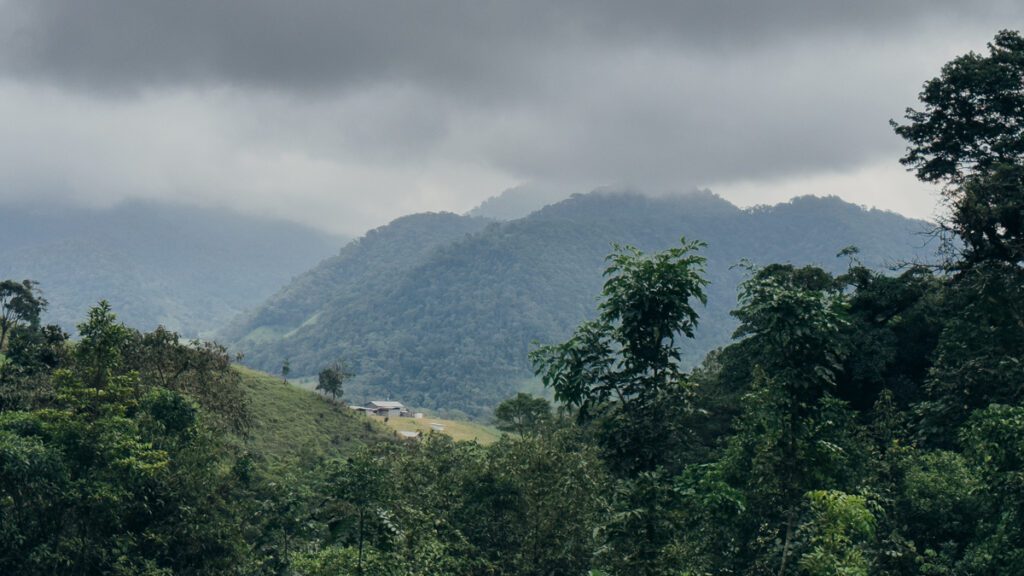
This article may contain affiliate/compensated links. For more information, please see our disclaimer here. We take all the efforts necessary to ensure the information included in this post is accurate, correct and current, sometimes, things just change! Travel information like opening hours, business operations and prices may change. If you find anything in this post that is incorrect or outdated, please let me know in the comments so I can update it for other readers. Cheers!
We love helping you plan amazing trips. If you need any of these services, consider booking them through our affiliate links. Without costing you anything extra, you will be helping support us so we can continue to write these blogs for you.
We thank you again for your continued support.
🏠 Find the perfect place to stay with Booking.com
✈️ Get the cheapest flights with Skyscanner
🚣 Book your favorite activities with Viator
💻 Make sure you have everything you need for your epic trip by checking our store on Amazon
Table of Contents
About Bajos del Toro, a hidden gem region in Costa Rica
Bajos del Toro proper is a town in the Alajela province of Costa Rica. We’ll talk about Bajos del Toro interchangeably referring to the town and the area in this article, as many other towns are pretty small here. Although to be honest, Bajos del Toro is also quite a small town itself!
Where is Bajos del Toro located?
Bajos del Toro is located about 2 hours from San Jose, to the northwest. It’s nestled in the valley between the Poas and the Cacho Negro Volcanos, at an elevation of about 1,500 m (5,000 ft). You’ll find the climate is cooler and wetter than other parts of the country. But this combination is also what creates mystical cloud forests. The mountains and valleys, as well as the many rivers running through the region, make it the perfect waterfall wonderland.
The region is centered around Route 708, mainly in the northern section. Most of the attractions in the area are located to the north of the town of Bajos del Toro. And as you’ll see, most of the attractions here are waterfalls!
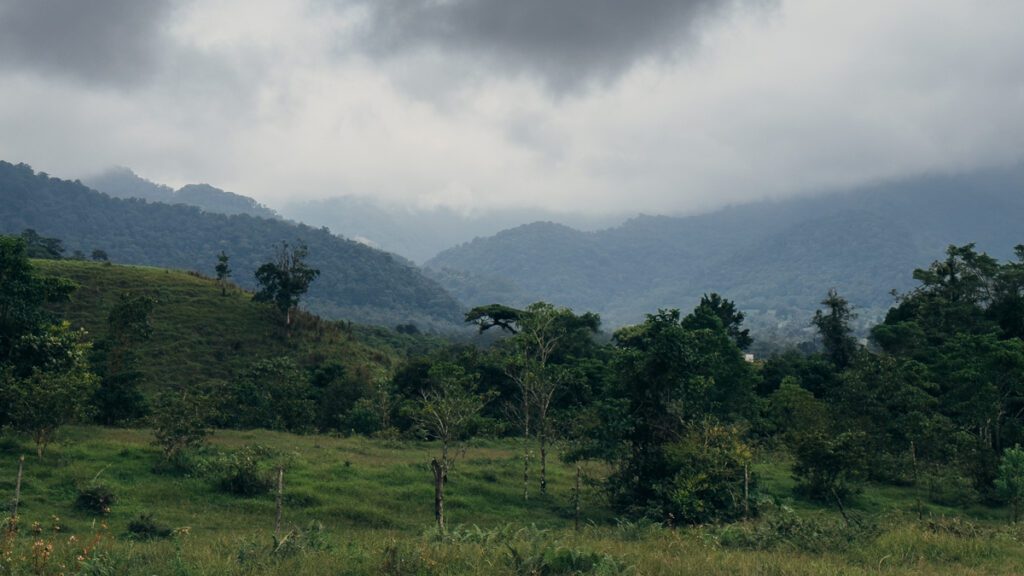
What to expect in Bajos del Toro?
Bajos del Toro is home to rolling hills and mountains, lush rainforests, rivers, lakes, rock pools and waterfalls. Name it! If it’s a beautiful natural phenomenon, you’ll find it in this area. It’s no wonder that the region is gaining popularity for those looking to spend time outdoors.
Eco-tourism fans will be able to go on hikes, whitewater rafting, horseback riding, or ziplining. Those who want to chill out can find a rock pool to hang out in all day. And those looking to see the most amazing waterfalls will be able to visit them all day, every day.
Bajos del Toro is a great option if you’re looking for a beautiful and adventure-filled destination to add to your Costa Rica itinerary. With its stunning waterfalls, lush rainforests, and abundant wildlife, there’s something for everyone in this hidden gem of a region.
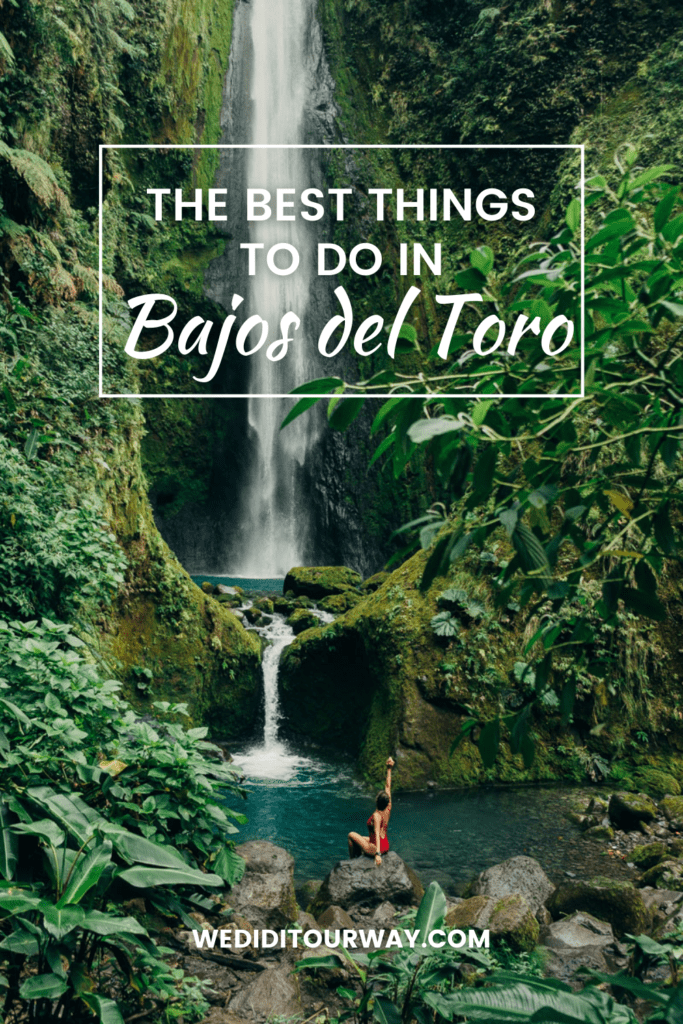
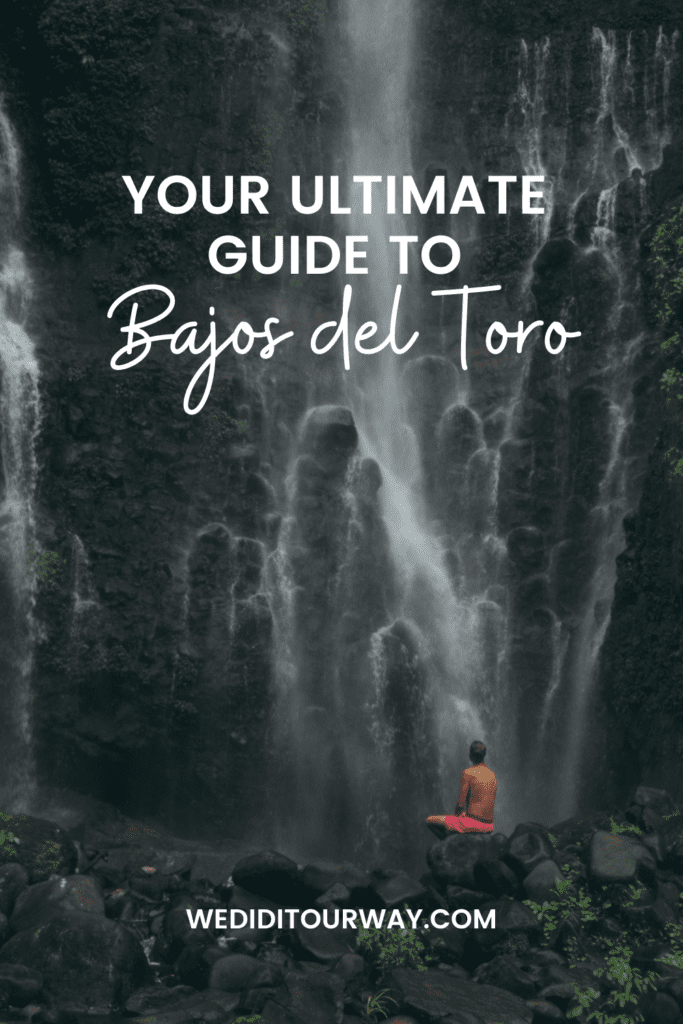
What to do in Bajos del Toro
Although the town and the region of Bajos del Toro are quite small, there is still plenty to do here. From rolling rivers, lush mountains, countless waterfalls, natural pools and volcanos, there is something for everyone here.
The best waterfalls in Bajos del Toro
Bajos del Toro is home to countless beautiful waterfalls. As we were traveling through the region and exploring each waterfall, we would joke that every farmer here has a fall in their backyard, and we might not be that far off from the truth!
Just visiting the waterfalls in Bajos del Toro would require a week in itself. But in case you don’t have that much time, here are the best waterfalls to visit in the area. If you have the time, there are plenty of other waterfalls all around the country as well.
A quick note: Although the weather is hot and the setting is tropical, the water in these waterfalls is far from warm or hot. In fact, it’s quite frigid at around 16-18 degrees C. And this is pretty much all year round. Of course, you can bathe in most of these waterfalls, but note that it will not be a relaxing experience – you will get cold!
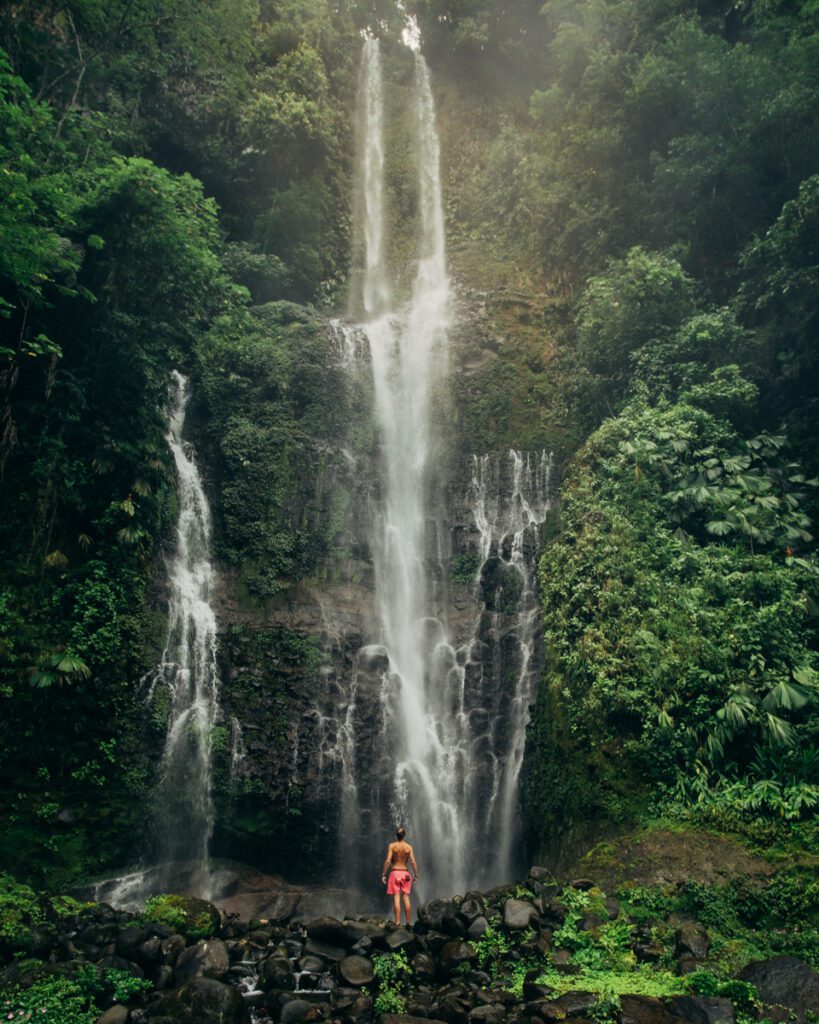
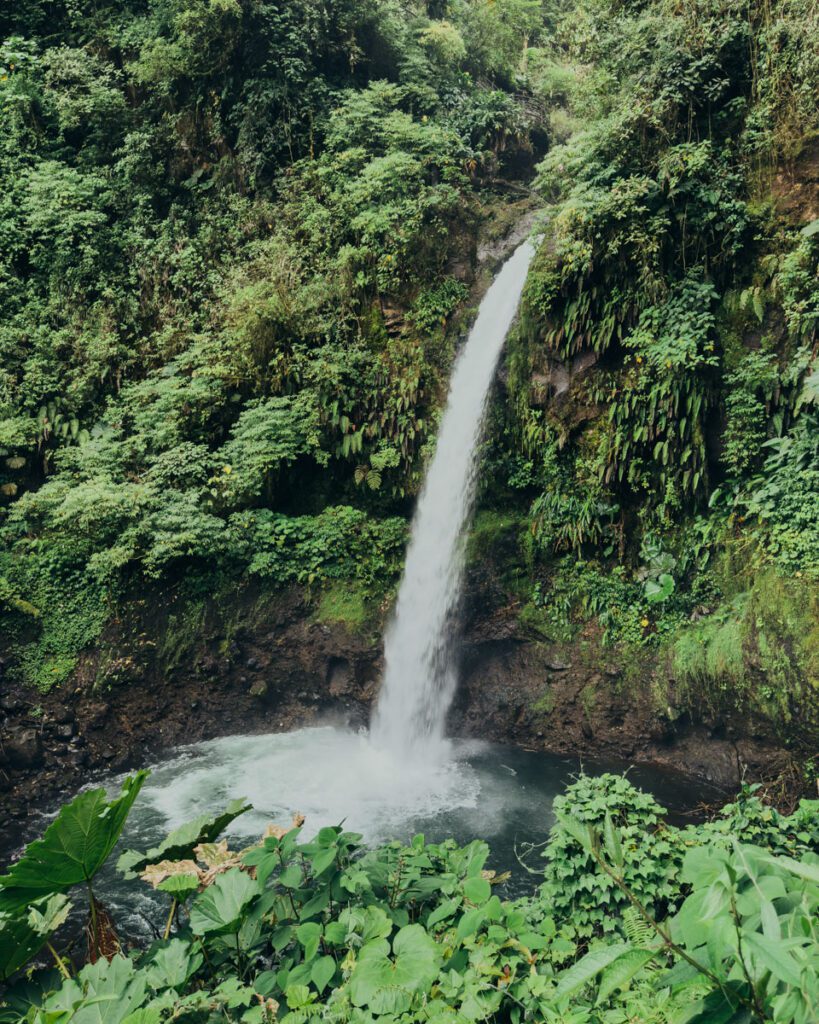
1. Discovering the Blue Falls of Costa Rica & Catarata del Toro
The Blue Falls of Costa Rica and Catarata del Toro are owned and operated by the same Dutch family. When visiting these falls, we recommend getting the combo ticket to both entrances so you can visit the 7 falls on this property.
The property is divided into 2: Catarata del Toro as well as the Blue Falls of Costa Rica. The first has one very tall waterfall, a million steps to trek and a beautiful garden to stroll in. The Blue Falls have 6 waterfalls on the property as well as natural pools to hang out in.
Each entrance ticket costs $15, but the combo price is $25 USD, or you can show them this coupon to get 15% off. Although the price is steep for Costa Rican standards, the property is very well-maintained and there is staff at most of the waterfall junctions and river crossings to help you make sure you don’t get lost.
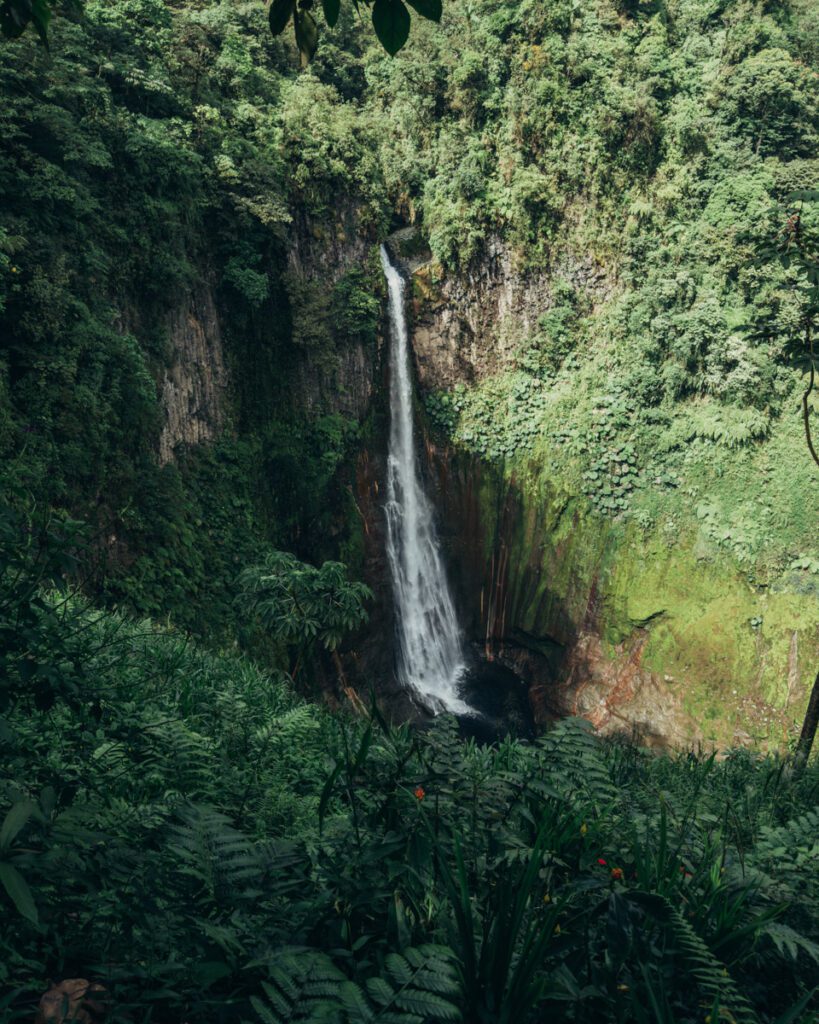
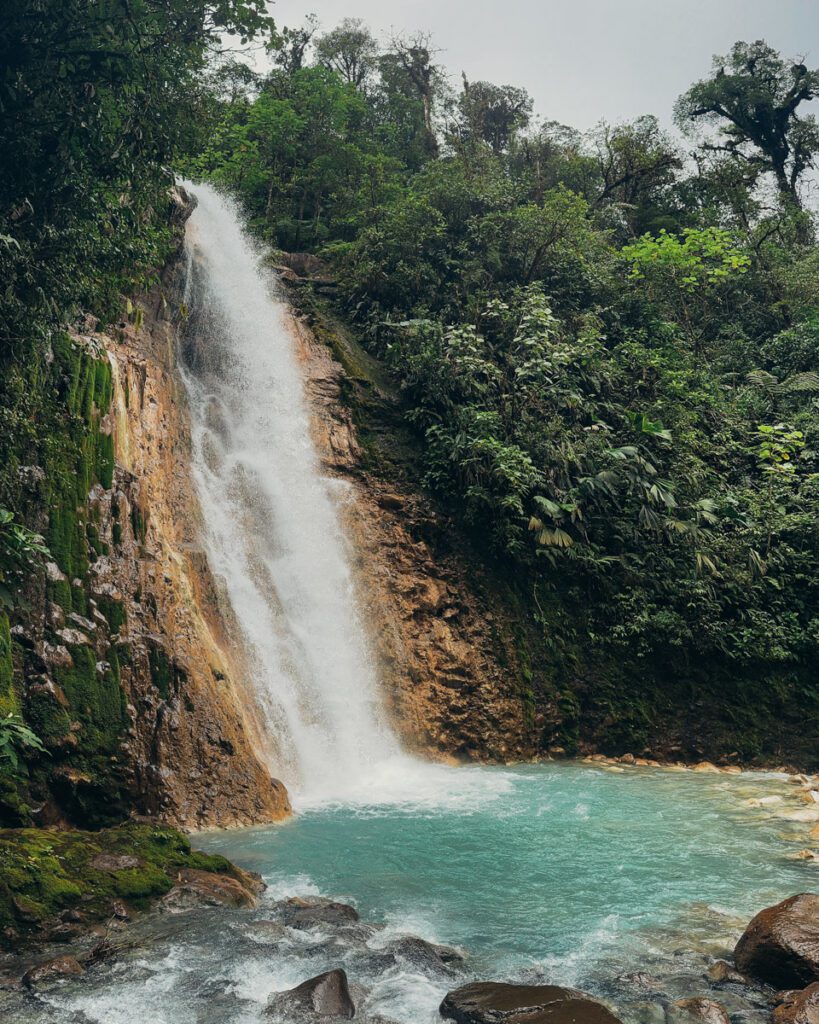
Overall, you’ll need about 45-60 minutes to visit the Catarata del Toro. The Blue Falls will require closer to 4-5 hours, depending on if you want to visit each of the falls, how long you spend at each one and if you choose to swim there.
You don’t need to be in crazy good shape to visit these waterfalls, but you should be in good health. You’ll be going up and down quite a few sets of stairs, crossing rivers and walking a lot. You can also opt to stay put and check out the closest falls.
It’s important to note that during the rainy season, some of the waterfalls may not be accessible because of flash flooding in the rivers you have to cross to reach them. The falls are open every day, except Sunday, from 7 am to 5 pm.
2. Checking out the family-owned Paraiso Manantiales waterfalls
Paraiso Manatiales is a family-owned property with about 6 falls to explore. The cost of entry is about $10 USD per person and they only accept cash here. They are open every day from 8 am to 3 pm.
Paraiso Manantiales also has a few cabins and campgrounds to rent, as well as a restaurant (but they don’t serve any vegan or vegetarian options). Their dishes are mainly traditional local dishes that include chicken, pork or beef.
You’ll need about 1.5-2 hours to explore all the waterfalls on the property and that time will vary greatly depending on how much time you spend at the natural pool. The property is not very big and there is only one natural pool. Most of the waterfalls are only for viewing. Overall, you have 6 waterfalls (depending on the season, as smaller ones sprout during the rainy season and 1 natural pool.
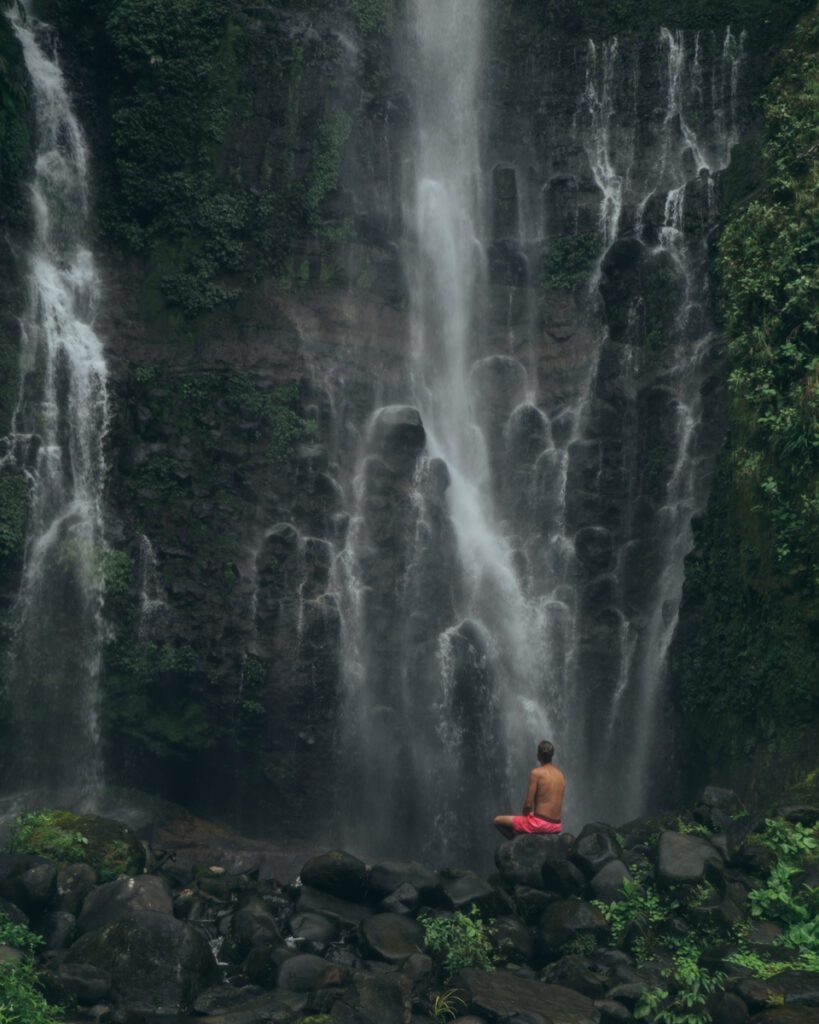
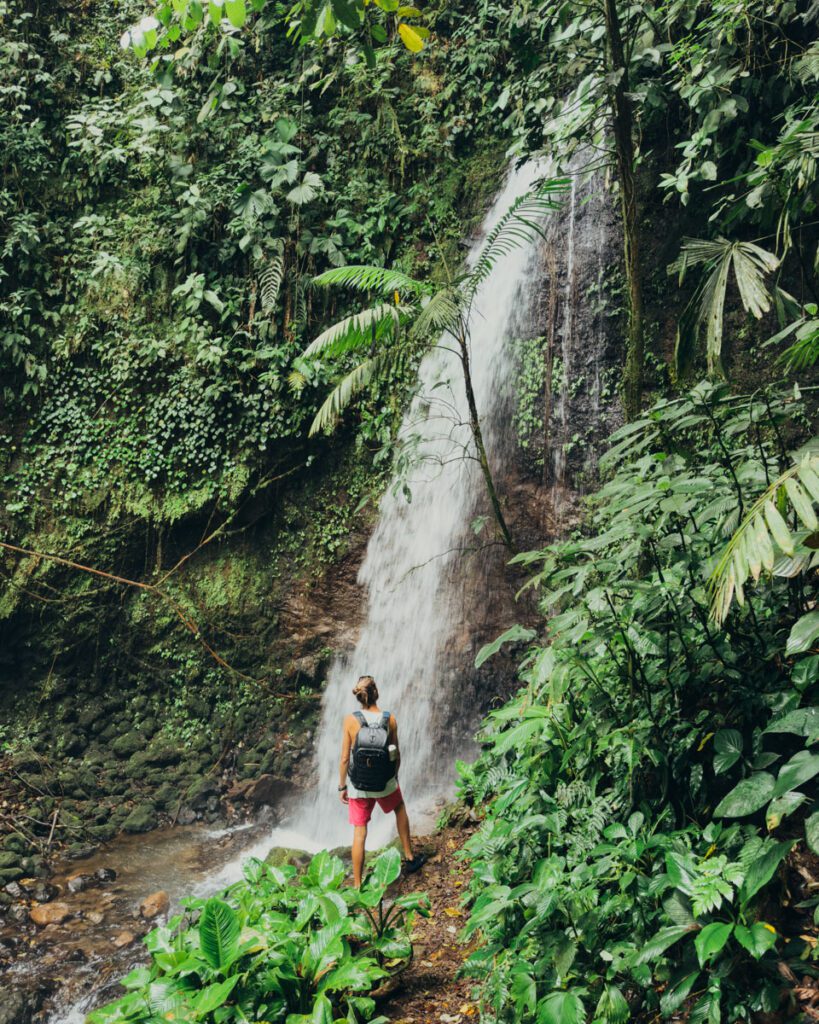
To visit this site, you’ll need to go down a steep spiral staircase and walk a few hundred stairs (up and down) in the forest. We recommend being in good health to take full advantage of this property.
There is also a cute handmade Pura Vida sign you can take a picture at when you visit this waterfall in Bajos del Toro. There are 2 trails to go around the property. We recommend heading first to the mirador then going on the trail down to the largest waterfall and the natural pool.
Because this site is not very well known, you can visit any time of day. You’ll mainly find locals here.
3. Tesoro Escondido, a hidden treasure of a waterfall in Bajos del Toro
Tesoro Escondido or Hidden Treasure, is another family-owned farm with a big waterfall on the property. It’s not very popular with tourists just yet, but you’ll find many locals here.
The cost of the entrance is $15 USD per person and this gives you access to one very tall waterfall, its droplet lookout and many natural pools. You’ll need about 1.5-2 hours on the site to explore it all. Of course, you may want more time if you’re going to lounge around in the pools (Pozas).
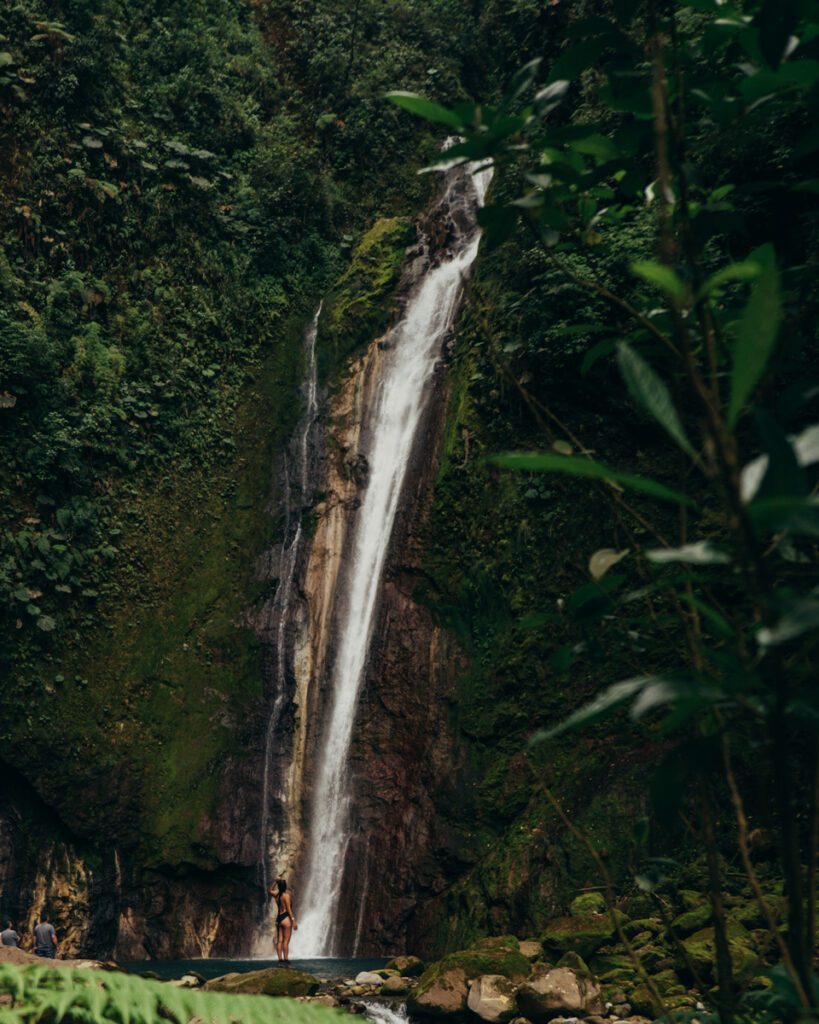
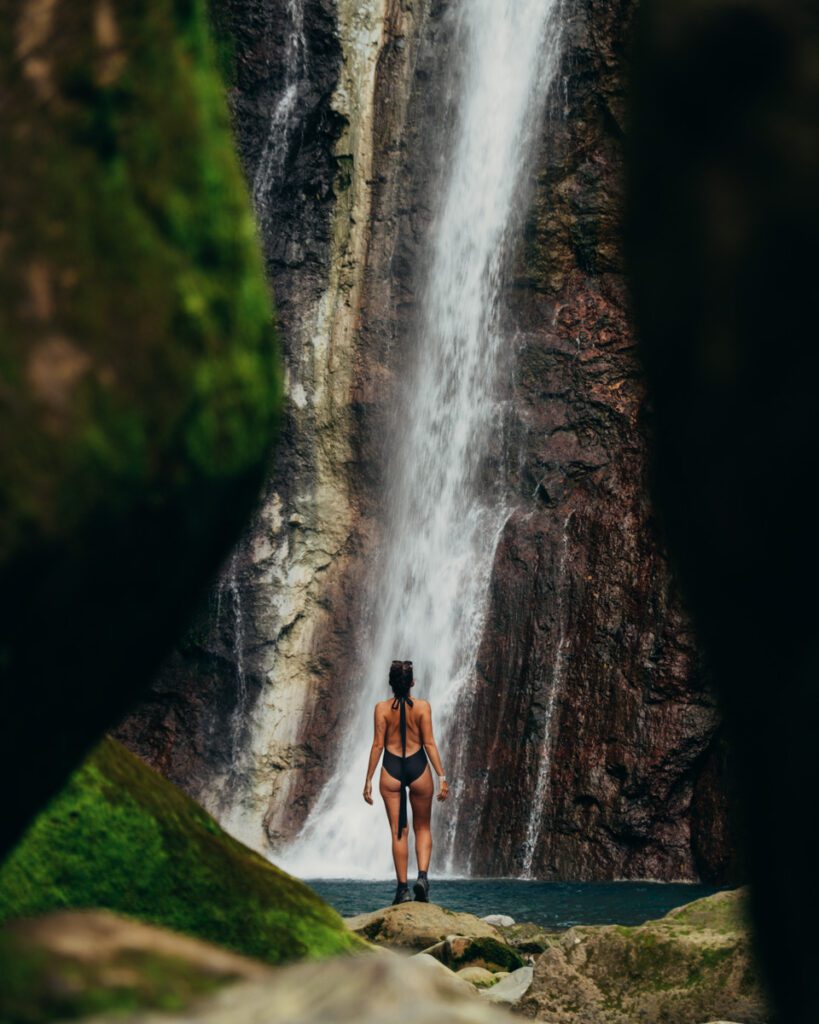
This is a fairly easy waterfall to access, but you still need to be able to walk through the forest and on rocky terrain. There are also quite a few steps to go up and down so keep that in mind as well.
This property is open from 8 am to 3 pm on weekdays and 8 am to 4 pm on weekends. They accept both cash and card payments.
If you want to know more about the Tesoro Escondido waterfall, you can check out our full article here.
4. Vuelta del cañon, an adventure hike to a stunning waterfall
This is the final waterfall we visited in Bajos del Toro, and it’s another family-owned farm with a big waterfall on the property. Did we tell you pretty much everyone has a waterfall on their property here?
The total cost for access to this waterfall is $16 USD per person and to be honest, the whole access part is a bit sketchy. There is a parking lot about 50m away from the entrance to the falls. When we arrived, there was no one at the parking lot so we made our way to the entrance. There, we were stopped by who we presumed was the owner and we paid him.
You can also camp on the property’s parking lot where they have a few showers and a bathroom available. They also have a covered area with picnic tables where you can set up camp.
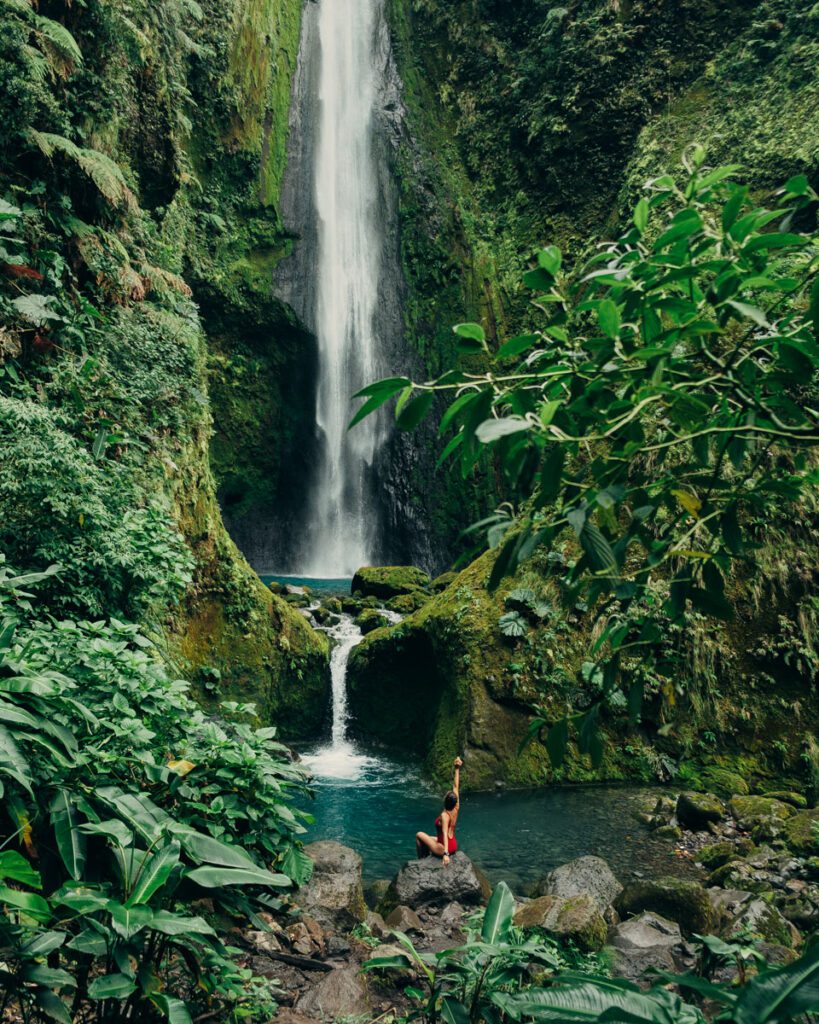
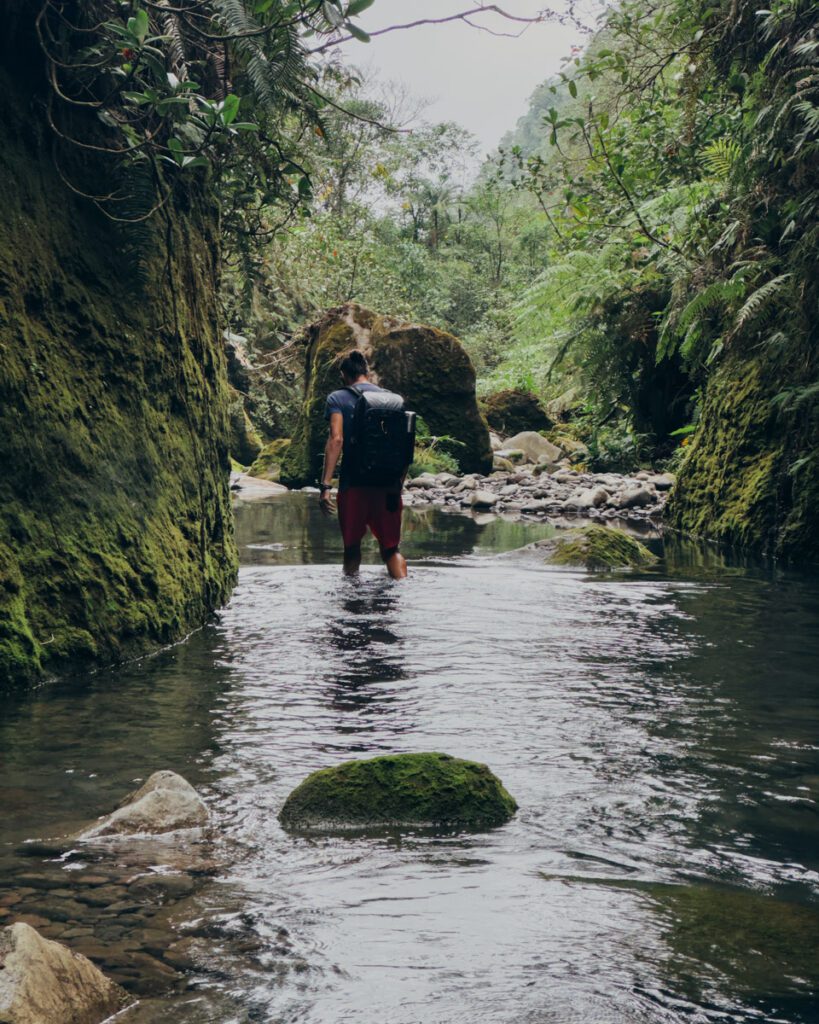
You must be in good physical health to hike this trail. Although there is no elevation gain, you do have to walk for about 1.5 to 2 hours each way, crossing rivers about a dozen times. The last stretch of the hike is through the river where, at the deepest point, you will be waist-deep in the river.
There is only 1 big waterfall to see here, and the hike will take about 4-5 hours depending on how much time you spend at the waterfall. Again, the water is very cold.
It’s best to start this hike very early, around 7-8 am, especially in the rainy season. Because you have to cross the river so many times, you can’t do this hike if it’s raining as the river risks flooding.
Other waterfalls in Bajos del Toro
There are many more waterfalls in the Bajos del Toro area, but we didn’t have a chance to visit them. Here’s what you need to know about them if you want to check them out:
- Quebrada Gata & Rio Barroso: It took me a while to get over the fact that we wouldn’t be able to hike to these falls. They look absolutely amazing, but they are tricky to hike on your own and you are very dependent on the weather because of the risk of flash flooding.
- Physical health: You’ll need to be in good physical health to hike these falls as the trek is about 6 hours long
- Cost: $45 USD
- Guides: To hike to these falls, we recommend you hire guides. The ones who came the most recommended to us were Toro Amarillo 360 Eco Tours.
- Rio Agrio Waterfall: This waterfall is located a few minutes away from the Blue Falls. Its name means Sour River because the pH of the water is much lower than in other places. This is caused by the nearby Poas Volcano which emits acidic ash and gases.
- Physical health: The trek to these falls is very short and not that steep so it’s accessible to most people
- Cost: $10 USD. For an extra $5 USD per person, you can gain access to DinoLand (on the property) and the Pozas Celestes (Blue Pools) across the street. This includes transport to and from the falls to the pools.
- Opening hours: Open every day from 7 AM to 5 PM
- Need more info? Check out their official site here
- Cascadas Pozo Azul: These are considered to be the tallest waterfalls in the area, standing at over 150 meters (500 feet). There are many waterfalls on the property but the main one is Catarata Caida Nieve y Paz.
- Physical health: You will need to be in fairly good health to visit this waterfall. The trek is about 2.5 to 3 hours long and there are many steps at the end of the hike to get to the main waterfall.
- Cost: About $6 USD per person
- Opening hours: Open daily from 6 am to 5 pm
- There are 2 other sets of waterfalls on the property and natural pools as well, so you can cool down before or after your big hike.
- Need more info? Check out their official site here
- Pozas las Presas: These are a set of small but beautiful waterfalls located on a family-run farm. We actually stayed on the property here but never had a chance to visit the falls because of the weather. The short trail goes through thick rainforests, hanging bridges and rustic wooden platforms.
- Physical health: This hike is short without much elevation gain, so you don’t need to be in great shape to access these falls.
- Cost: $5 USD per person
- Opening hours: Open daily from 8 am to 6 pm
- Need more info? Check out their official site here
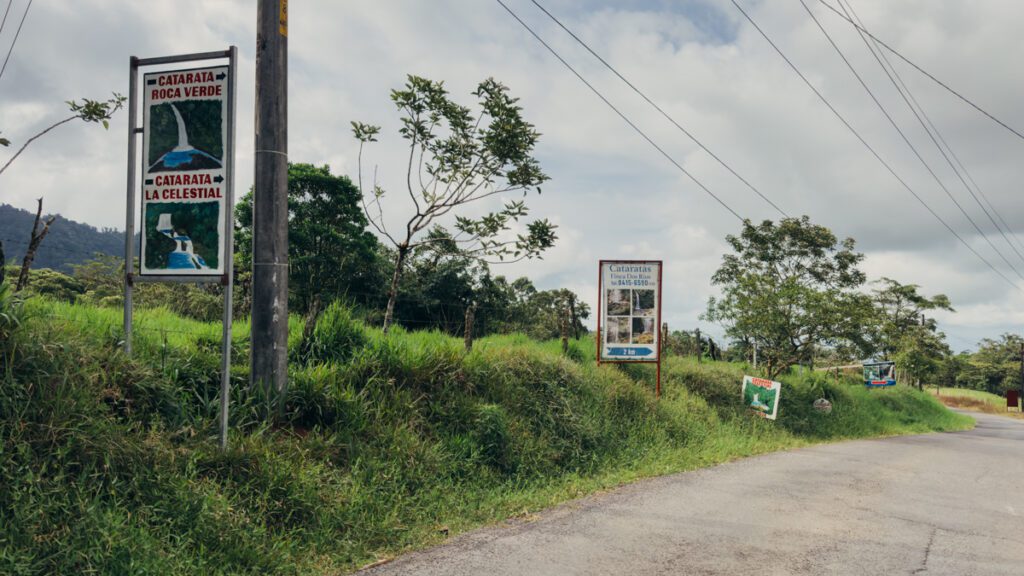
We weren’t joking when we said that there was a waterfall in everyone’s backyard. In fact, as you’re driving around Bajos del Toro’s main route, Route 708, you’ll see signage on the side of the road advertising the many waterfalls on certain properties. If one of them catches your eye, go in and take a look. There are too many waterfalls to list them all here! Plus, you’ll be helping a local family out, and that’s always fun!
If you want to explore even more waterfalls in other parts of the country, make sure to check out our full article here.
National parks in Bajos del Toro
On top of the amazing waterfalls in Bajos del Toro, there are also plenty of national parks and natural reserves in the area. You’ll find the Poas Volcano National Park and Juan Castro Blanco National Park in the area, while Carara National Park is nearby.
If you’re looking to do something other than visiting waterfalls, here are your different options in terms of national parks in and around Bajos del Toro.
1. Poás National Park, an active volcano park in Bajos del Toro
The Poás National Park is located in the Bajos del Toro region. You’ll see many signs pointing to it all around. And if you have the chance, we recommend you stop for a visit.
As its name indicates, the Poás Volcano National Park is home to the Poás Volcano, an active volcano that has one of the largest craters in the world. You can even walk to the edge of the crater to peep the turquoise-colored lake inside.
The park has a few ecosystems within it, that make it super special to visit. You have cloud forests and tropical rainforests. This duality makes it a great place for birdwatching and hiking. There is also a visitor’s center that has the most up-to-date information about the volcano and the ecosystems.
The park is open daily from 8 am to 4 pm. But you can only access it if you’ve reserved online before. The entrance fee for visitors is $15 USD per person.
Make sure you check their official website for information as the volcano is still active and can erupt.
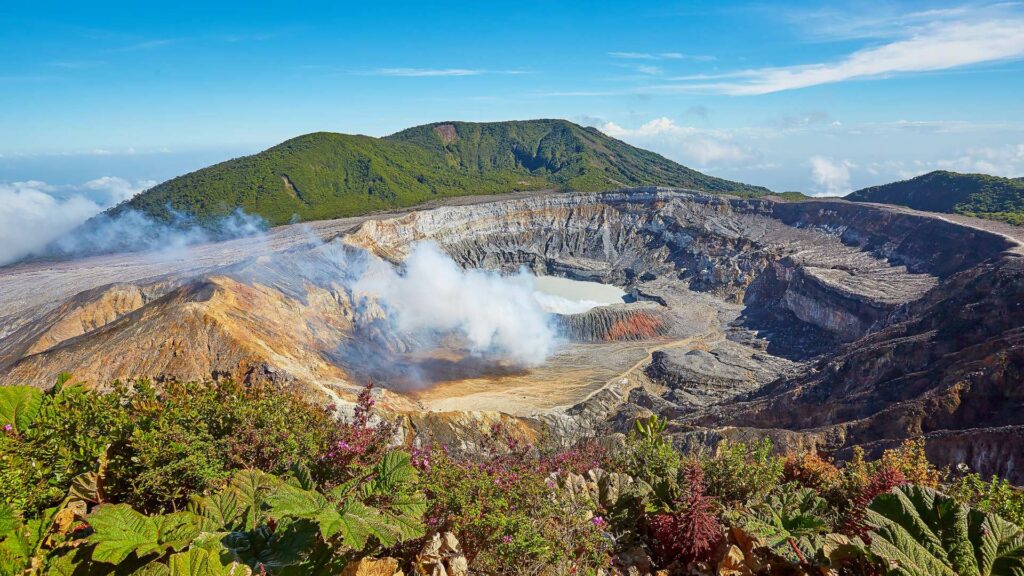
2. Juan Castro Blanco National Park, a paradise for hikers and nature lovers in Bajos del Toro
The Juan Castro Blanco National Park one of the least visited national parks in Costa Rica. It is said that there are only about 1,000 visitors annually, so if you’re looking for untouched beauty, this is the place for you. In fact, this national park in Bajos del Toro is one of the newest parks and sections of it that are still privately owned.
Juan Castro Blanco National Park is known for its volcanic landscapes, lush forests, and many rivers and waterfalls that shape its silhouette. The park is home to many hot springs and is bordered by three volcanos. It also has a rich history as there are many archeological sites on the grounds.
Because of its unique offering, and the fact that it’s often overlooked, Juan Castro Blanco National Park still offers untouched beauty to admire. The park is home to 233 different bird species and 57 mammal species. For those who love to bird-watch, you can spot peacocks, quetzal, black turkeys, and falcons.
The park is open on weekdays, from 9 am to 4 pm but seems to be closed on weekends. At the moment, there isn’t much information about the park but as the government invests more into purchasing from the private owners and developing its infrastructure, it should become available.
For now, if you’re looking to discover a real hidden gem of a national park in Costa Rica, this is the one for you!
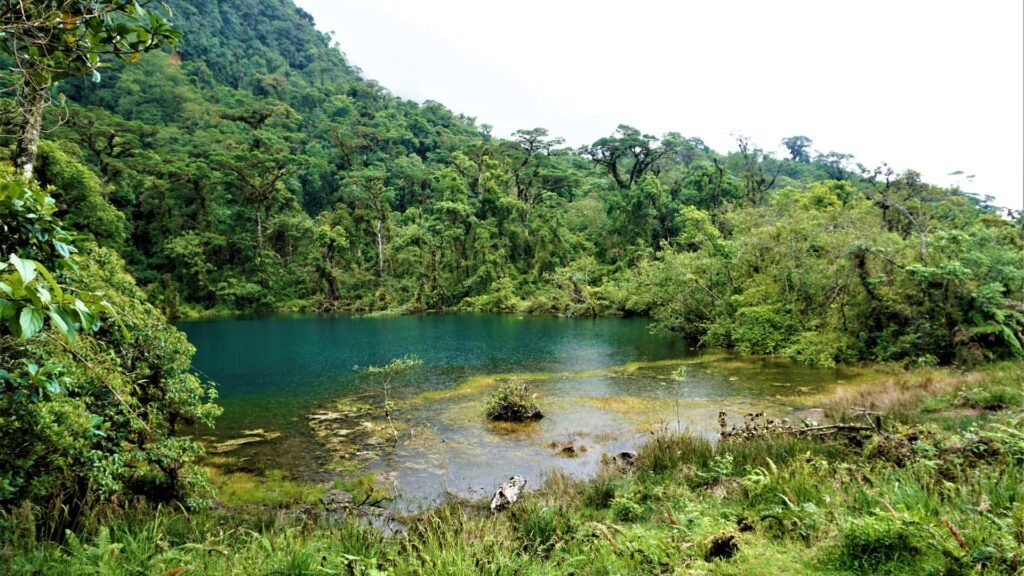
3. Carara National Park, close enough to Bajos del Toro, a paradise for bird lovers
Although this park is not located in the Bajos del Toro region, it’s still close by and worth the visit, if you have the time. However, it’s important to know that because of its close proximity to San Jose, Carara National Park is one of the most visited parks in Costa Rica. It’s also the park where many cruise ship passengers are bused for a day trip when they dock at Puerto Caldera.
In fact, most people don’t realize that when they get to the famous Crocodile Bridge (on the way down the coast from San Jose to Jaco or Quepos, they are peeping into the national park.
Nevertheless, the Carara National Park is known for its diversity of bird species and stunning hiking trails. Here, visitors can spot scarlet macaws, toucans and many more. The park is also known for its rich biodiversity, as much for the animals as the plants and flowers that grow here.
The park is generally open from 7 am to 4 pm. Regardless of when you visit, the weather will be hot and humid. For this reason, you should wear sun protection and bring lots of water.
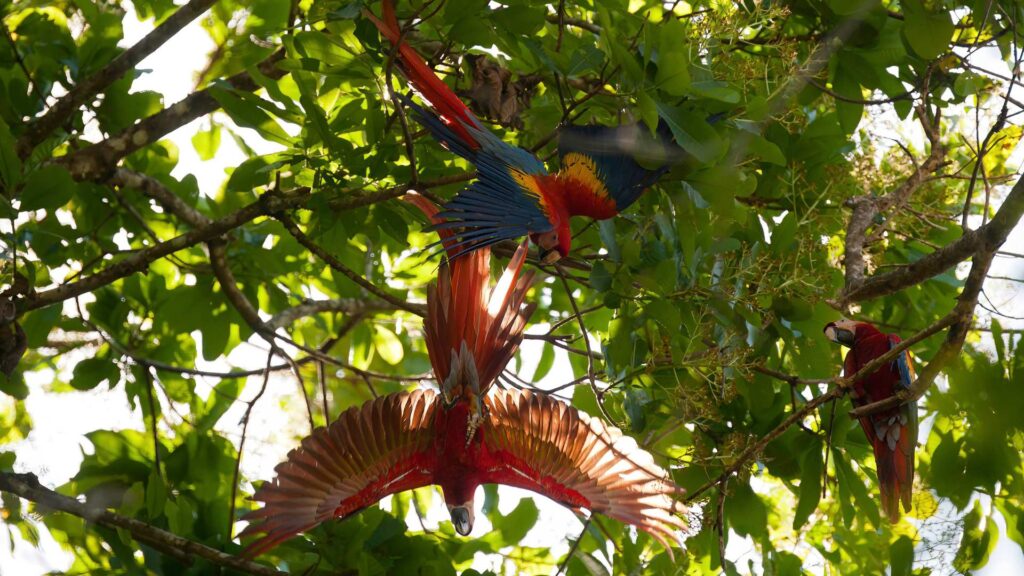
Other activities in Bajos del Toro
There are so many different things to do in the Bajos del Toro area. From hot springs to adventure activities to canyoning and more. Here are some of the best things to do that are not waterfalls or national parks.
1. Check out the Pozas Celestes (Blue Pools) for a relaxing moment
The Pozas Celestes or Blue Pools are located near the Rio Agio waterfalls and Dino Land. Although they are not yet popular with tourists, they are quite the attraction for locals.
In fact, if you want to have the pools to yourself, we recommend visiting mid-week and as close to opening as possible. Most people start trickling in around 9 am.
The pools are a very beautiful blue-turquoise color, which makes them an attraction for most to see. There are a few pools on the property but there is only one pool you can swim in. It’s important to know that the water is very cold!
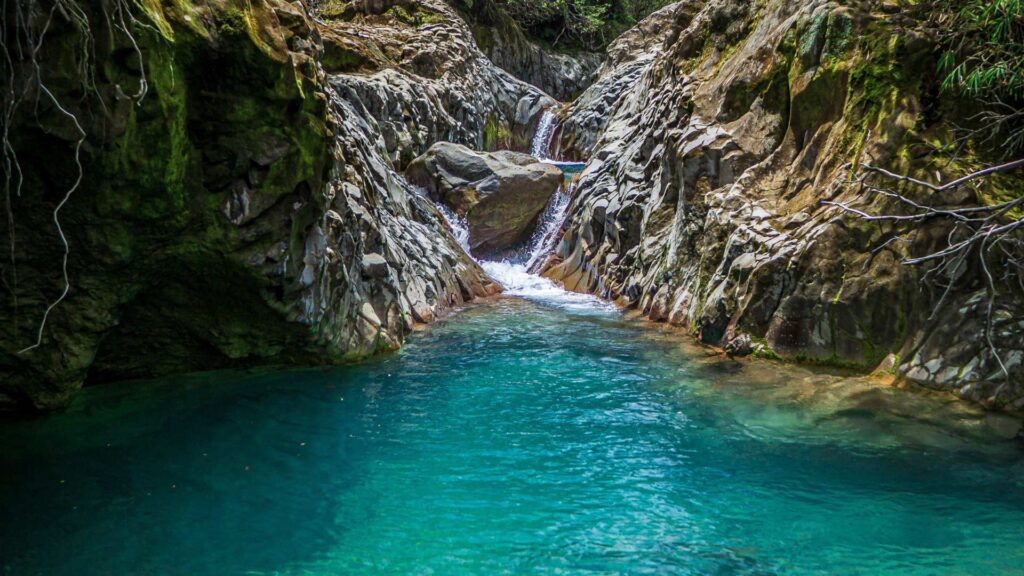
The blue coloration comes from the slow-moving water in the nearby river that feeds the pools. The water collects mineral deposits and when stirred up by the current, the minerals reflect the intense blue color. Just note that if it has rained before your visit, the water will be more brownish. If you want the best conditions for seeing the bluest waters, you’d need to visit on a sunny day.
The Pozas Celestes are open every day between 7 am and 5 pm. If you only want to visit the Blue Pools, the entrance fee is 3,000 Colones (about $6 USD). But you can also buy a combo ticket to visit Rio Agio Waterfall and you’ll only pay 6,000 colones for both, which is a 1,000 colones discount.
There is parking on the property and it’s free. Your ticket also includes access to their shuttle to the trailhead. The ride takes around five minutes and runs on demand. You can also arrange a pickup time with the driver.
2. Take a dip in the hot springs in the area
Although the water coming from most rivers and waterfalls is very cold in Bajos del Toro, there are also hot springs in the area.
Since there are many volcanos in the area, the waters get warmed up by volcanic activity. Many of the places offer a spa-like experience with massages, mud baths and masks and much more. A few of the places have accommodations as well.
Here are some of the places that offer a thermal springs experience are:
- Recreo Verde: This spot has everything you need to have an amazing vacation. They offer 9 semi-equipped cabins as well as a camping area, recreational areas, a soccer field, a beach volleyball field, a restaurant with delicious Costa Rican cuisine, and hiking trails to immerse yourself in nature.
- Termales La Cascada Hot Spring: This is another spa with accommodations on site. They have thermo-mineral natural springs, various swimming pools, jacuzzis, and a restaurant on location.
- Termales del Valle: Another natural hot spring that offers naturally heated pools where you can hang out. They also offer accommodations so you can take your relaxation to the next level.
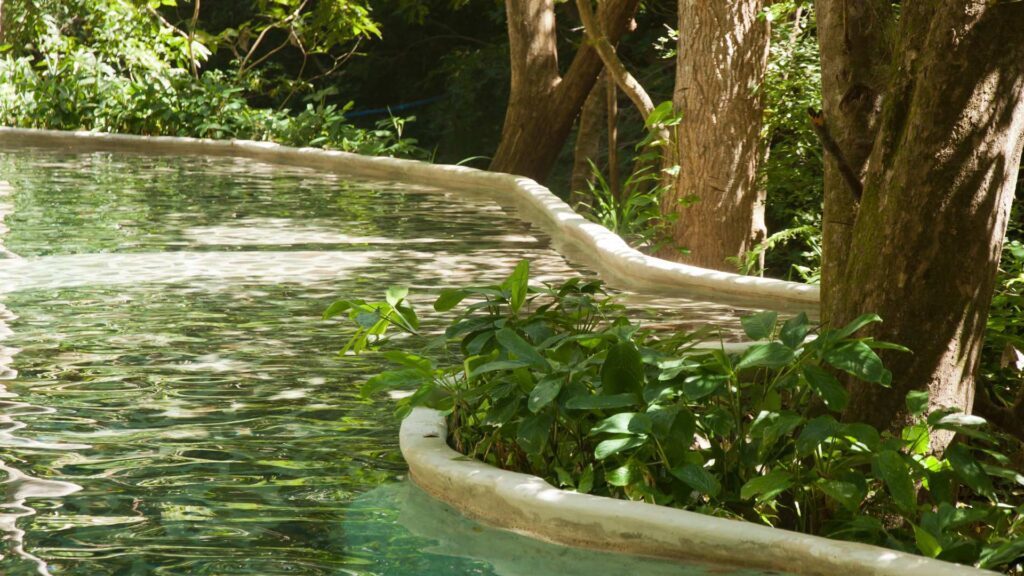
3. Go on an outdoor adventure in Bajos del Toro
Beyond the hot springs and natural pools, there are plenty of adventure activities to have in Bajos del Toro. Whether you want to get your adrenaline pumping by going ziplining, rappelling down a waterfall or going canyoning to explore even more waterfalls, there’s something for everyone.
Here are a few options of things you can do in the area
Amenities in Bajos del Toro
As we mentioned before, Bajos del Toro is a small town and a fairly unknown region for now. You can’t expect to have many amenities here, although, you will find some things in the area. We just want to manage your expectations as it is quite a small region.
Hotels in Bajos del Toro
There are a few hotels and accommodations to choose from in the area. You can also camp at many of the farms or waterfall parks in the region. Plus, there are many locals who have set up Airbnb’s here, so you have quite a few options to choose from.
In terms of hotels, as always, it all depends on your budget and the amenities and comforts you’re looking for. Here are a few options:
- Budget-friendly: Las Cabañas. Hospedaje Las Orquídeas
- Mid-range: Hotel Mango Valley. Selvática del Toro.
- Higher-end: El Silencio Lodge & Spa. Bosque de Paz Reserva Biologica.
We also noticed that many properties with waterfalls (aka farms, most of the time) offer camping on their grounds. The amenities they offer vary.
For example, we saw you could camp at the farms where the trailhead is for Vuelta del Cañon waterfall. They offered a few showers, one toilet, an outdoor sink and a communal sheltered area. You can park on their lawn to set up your tent or park your campervan. They were asking for 5000 colones ($10 USD) for an overnight stay for 2 people.
Paraiso Manantiales also had a similar offering with cabins and campgrounds. Your best bet would be to ask when you are there, or take a look on the iOverlander app and see where there are places to camp.
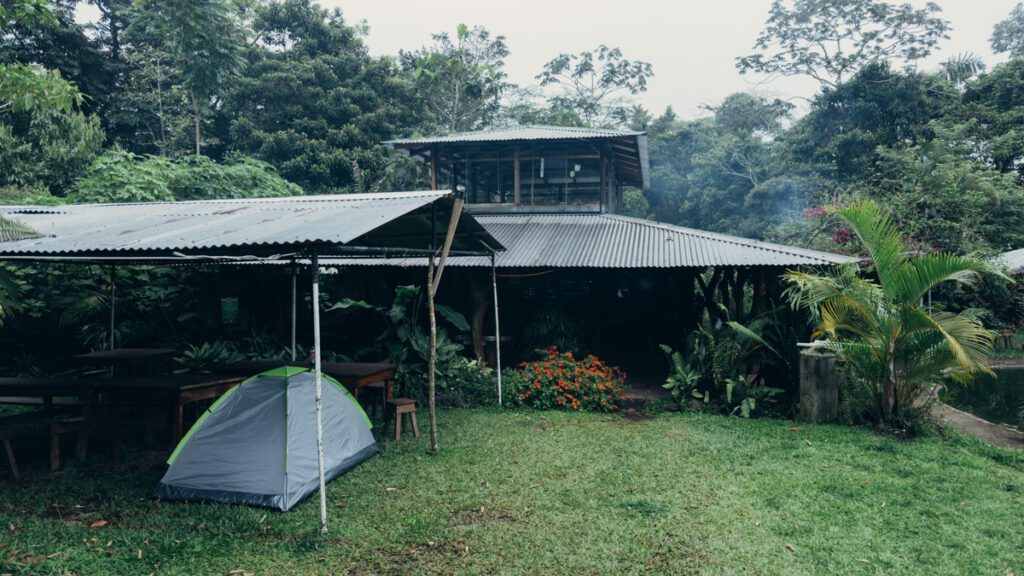
Restaurants in Bajos del Toro
We’ll be honest with you (as always). The food in Costa Rica was not our favorite. Compared to other Central American countries, we found that food was often overpriced with small portions and underwhelming flavor. Derek always tell me I’m not the right person to judge the local cuisine, but rice and beans are vegan… so I can judge!
In terms of restaurants in Bajos del Toro, don’t expect too much. Although there are a few options available, most offer typical local cuisine. If you’re looking to get more adventurous, we recommend getting a place with a kitchen. This way, you can cook your own meals. This is mainly what we did.
Here are a few restaurants that stood out to us and that have good reviews:
- Las Ventanas Restaurant: They offer mainly Costa Rican dishes, as well as international meals. As its name suggests (Ventana means window in Spanish), you can admire the beautiful view of the surrounding mountains from here.
- Restaurant Tipico Toro Amarillo: This restaurant also serves traditional Costa Rican cuisine, such as gallo pinto, casado, and ceviche. It is a great place to try local flavors.
- Mia’s Pizza: This restaurant serves delicious wood-fired pizzas, as well as other Italian dishes. It is a great place to go for a casual meal or to try something different.
- Freddo Fresas Restaurant: This restaurant serves fresh strawberries, as well as other fruits and pastries. It is a great place to go for a healthy snack or dessert.
[Image of Freddo Fresas Restaurant in Bajos del Toro] - Blue Morpho Restaurant: This restaurant offers a variety of international dishes, as well as a wide selection of vegetarian and vegan options. It has a beautiful view of the surrounding rainforest.
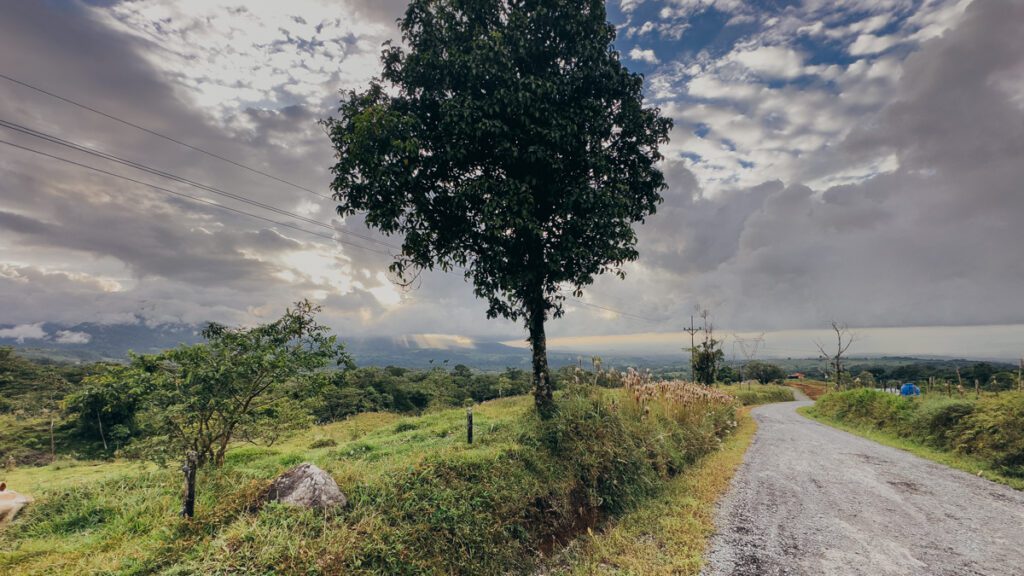
Groceries & gas stations in Bajos del Toro
The best piece of advice we can give if you’re visiting Bajos del Toro is to come prepared. If you’re looking for specific foods or meals, chances are, you won’t find them in Bajos del Toro. In fact, fruits and veggies were very hard to come by in the area, unless you have a craving for strawberries. Because the area is known for growing them.
In the little tiendas (or grocery stores) in the area, you’ll find canned goods and prepackaged foods like pasta sauce, bread, cereal, cookies, etc. But most of the stores we walked into didn’t have a big selection of food, and they certainly were lacking in the fresh produce section.
Since Carine is vegan, we don’t often go out to restaurants as the plant-based offering is not that great or varied. But there are a few restaurants in the area. The only thing to note that in the rainy season, operation hours may vary as there aren’t too many tourists around.
As for gas stations, there are a few in the area, but they are quite scarce. Again, the best recommendation would be to be prepared. We filled our tank as we got closer to Bajos del Toro. During our 4 days in the area, we would drive up and down the main Route 708. Since most of the attractions are concentrated on this main road, you don’t end up using that much gas. At the end of our 4 days in Bajos del Toro, we had used less than half a tank of gas.
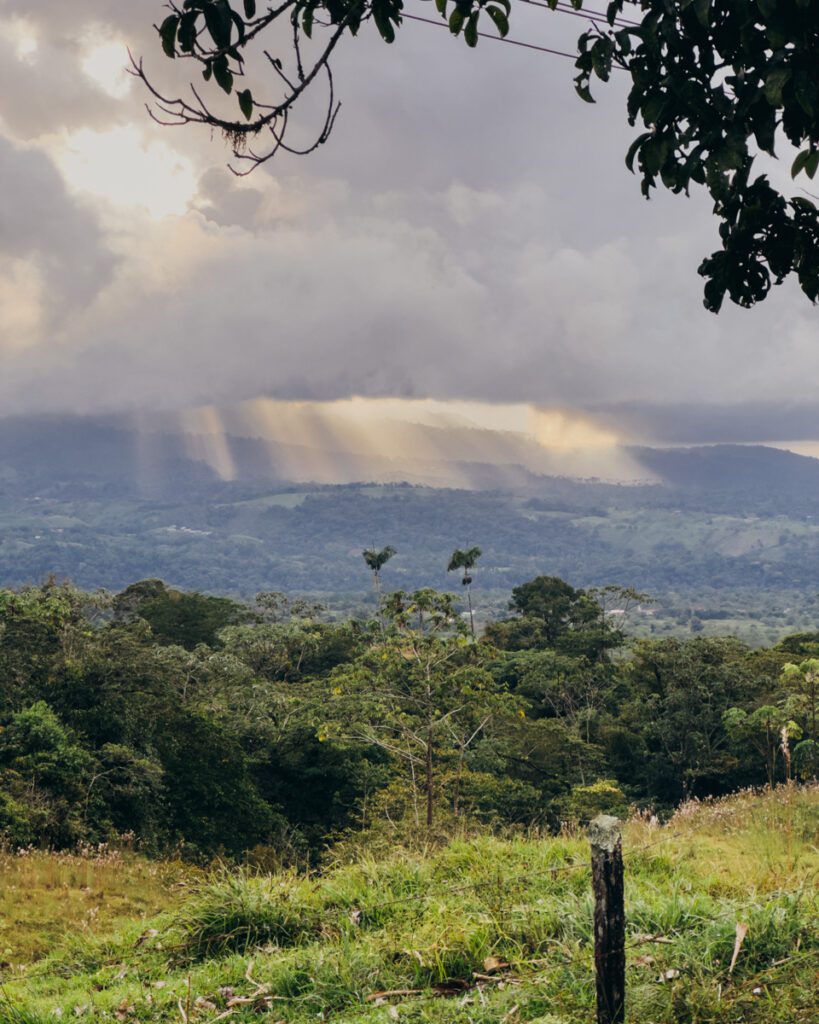
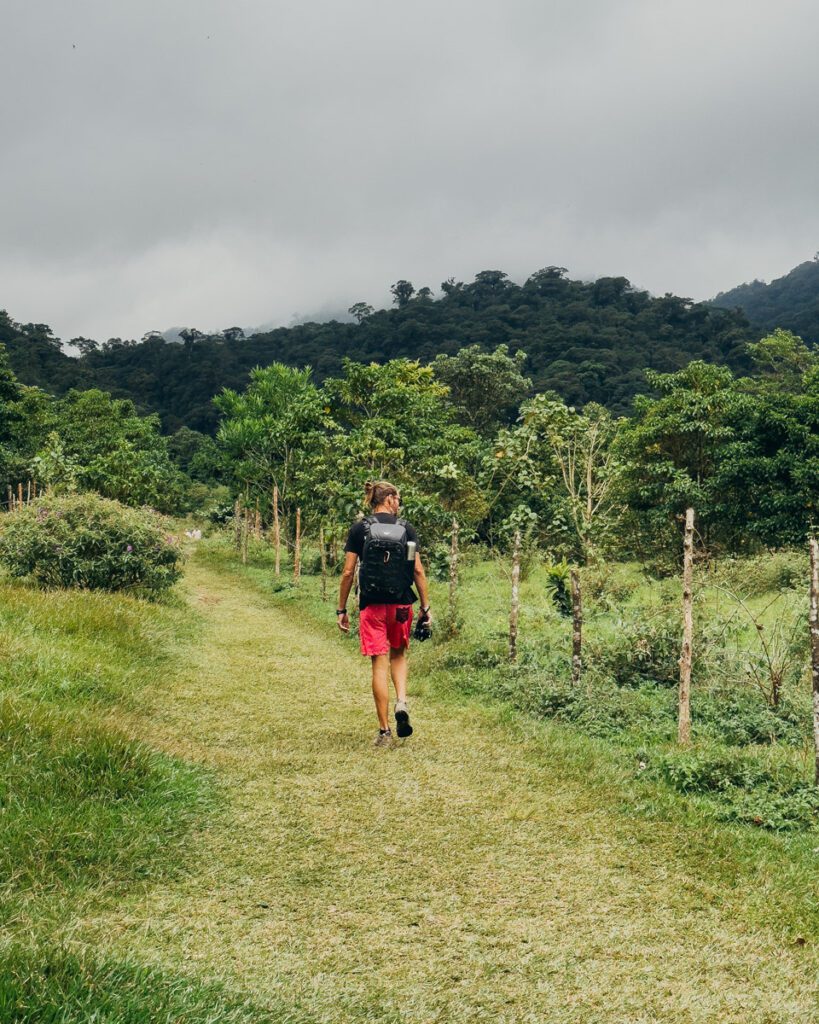
Banks & ATMs in Bajos del Toro
At this point, you won’t be surprised to learn that there aren’t really banks or ATMs in town or in the area. With a quick Google search, we see that the closest ATM is about an hour away… so once again, come prepared!
We did notice that a lot of places, from grocery stores to waterfalls to restaurants do accept credit cards, so that is always an option that’s available. But the best thing would be to bring some money with you. You don’t need to have a crazy amount unless you expect to be paying everything in cash… But we don’t recommend that.
In fact, we recommend you pull out Costa Rican Colones, as it’s the most accepted currency in the area. There are certain places that will take USD, but we found that most businesses had their pricing and ran their businesses in the local currency.
Driving in Bajos del Toro
Although Bajos del Toro is located in the mountains, surrounded by volcanos, you don’t particularly need a 4×4 to get around here. The vast majority of the roads are paved and fairly well maintained. Although some of the properties with waterfalls have entrances that are quite steep and bumpy, you can easily get by with a regular car.
As we mentioned, the most important thing is to fill up your gas tank before arriving in the area. This way, you can make the best of your time there without having to worry about it. Anyway, most of the attractions are off Route 708, so you won’t be driving too far. In 30 minutes or less, you can reach the furthest point of interest.
When is the best time to visit Bajos del Toro?
Because of its elevation, Bajos del Toro has a more mild climate. The temperatures here are a bit cooler than in the rest of Costa Rica, so if you’re going around in a campervan, you may want to have layers available. But overall, you can expect the same two seasons in Bajos del Toro as in the rest of Costa Rica – the dry season, from December to April, and the wet season from May to November.
If you plan on visiting Bajos del Toro to make the most of the waterfalls but want to avoid having too many people around, we recommend going in April-May. When we were there in July, the constant rain made some waterfalls inaccessible and we had to work around the rainfall, as the water would either turn brown or the rivers would flood.
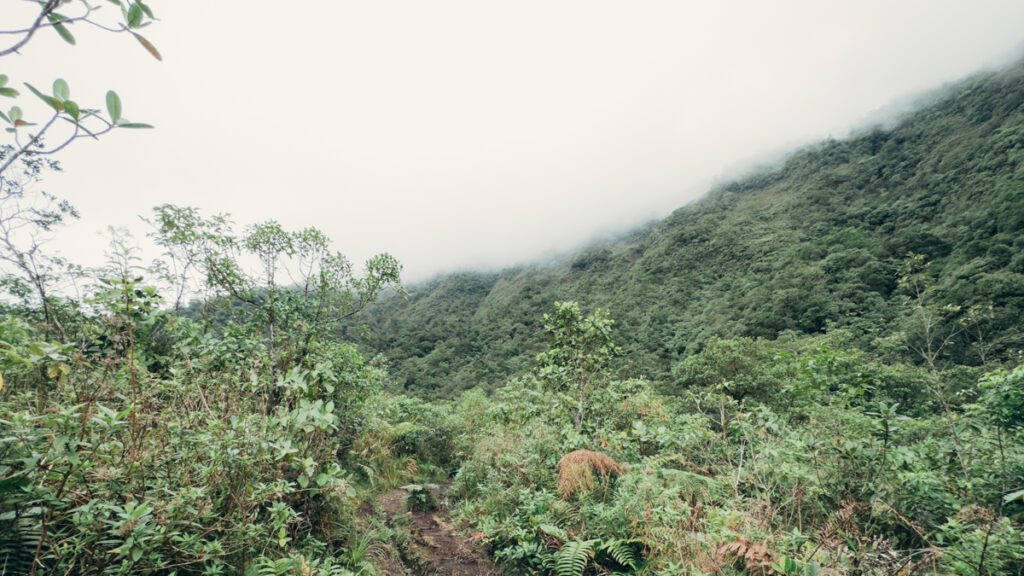
During the dry season in Bajos del Toro, the weather is more predictable and drier. Days are sunnier with comfortable temperatures. Basically, it’s the ideal temperature for hiking, birdwatching and exploring.
During the Green season, or the rainy season from May to November, you can expect rain every day, but only for a few hours a day. Rainfall tends to be in the afternoon, later in the evening or overnight. Because of this, we recommend getting the highlight activities done in the morning so you don’t have to worry about the weather.
Although the Bajos del Toro region is not super touristy just yet, the rainy season sees fewer crowds, so you can have places to yourself, especially if you arrive early. It’s also when the forest and the mountains are more lush, showcasing a variety of shades of green. Just be prepared for sudden weather changes – so always have rain gear ready and dress in layers.
What to pack when visiting Bajos del Toro
As we mentioned, Bajos del Toro has more mild weather than coastal Costa Rica. For this reason, it’s important to have a few things with you:
- A rain jacket, especially in the rainy season
- A sweater for cooler nights
- A pair of pants always comes in handy at night
- Sturdy hiking shoes (boots aren’t required) if you plan on exploring the waterfalls
- If you have water shoes, they’re also great to have for swimming in the natural pools and for certain river crossings on hikes
- Sturdy sandals (Chacos) are also great for hikes that require river crossings
- A bathing suit for all the waterfalls and pozas
- A quick-drying towel
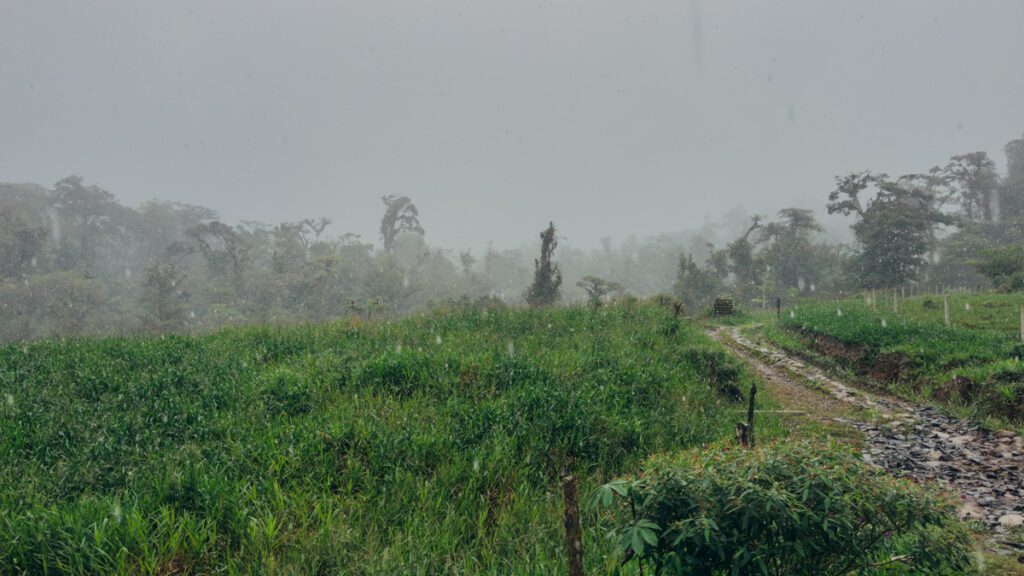
How long to spend in Bajos del Toro?
The ideal amount of time to spend in Bajos del Toro is 3-4 full days. This will give you enough time to visit the different waterfalls, take some time to relax and go on some hikes as well. If you like to keep a good pace on vacation, 3 days will give you time to do 2 activities a day and experience the best of Bajos del Toro.
During the rainy season, you may have less time to spend outdoors as afternoons tend to be rainy and some waterfall sites close down because of rivers flooding.
A quick note: Since Bajos del Toro is not very touristic yet, most people don’t speak English. To make things easier for you, we recommend learning some basic Spanish to get around. Of course, most locals can help you with minimal English, but it is very limited.
Exploring the best of Bajos del Toro
We really hope that this article has convinced you to visit Bajos del Toro. The region is still fairly unknown to tourists although locals have a real love for it, and we can see why.
If you’re looking for fewer crowds, lush landscapes, stunning waterfalls and volcanos all in one beautiful package, Bajos del Toro is the place for you. For outdoor enthusiasts, wildlife photographers and waterfall chasers, this is the perfect little region to explore.
Let us know in the comments if you’re ready to explore the beautiful Bajos del Toro. What are you most excited to see? Are there any other places or activities we should include in our article?
Thank you so much for reading the article all the way through!
We put a lot of time and effort into the content we create. Please like, comment and share – every action on your part helps us out tremendously and is very appreciated.
You can also help us by pinning this article for others to find.
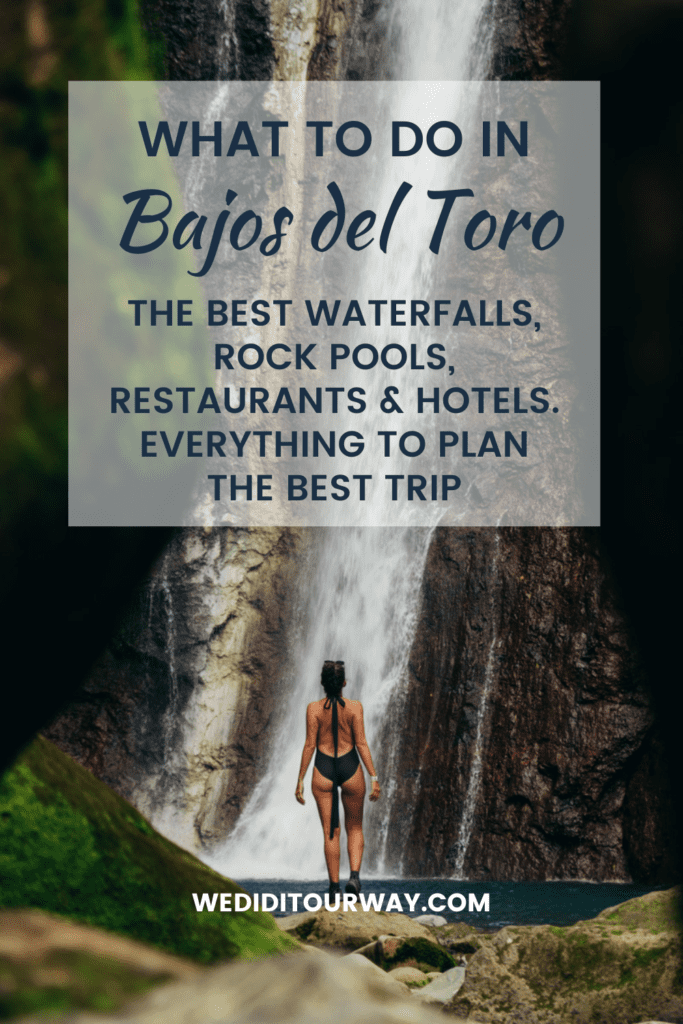
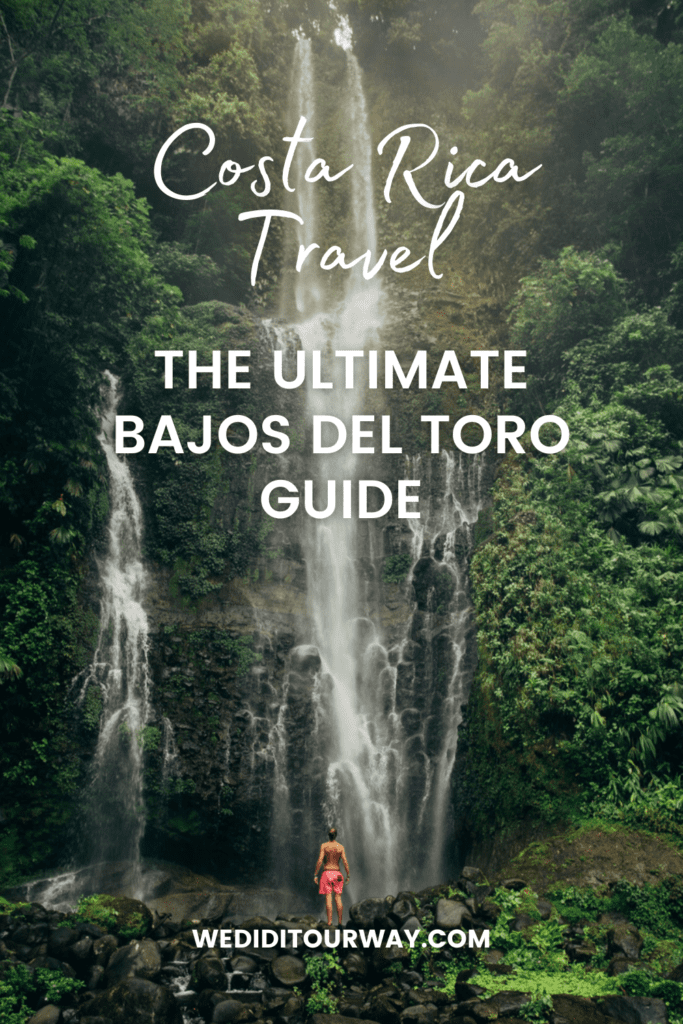
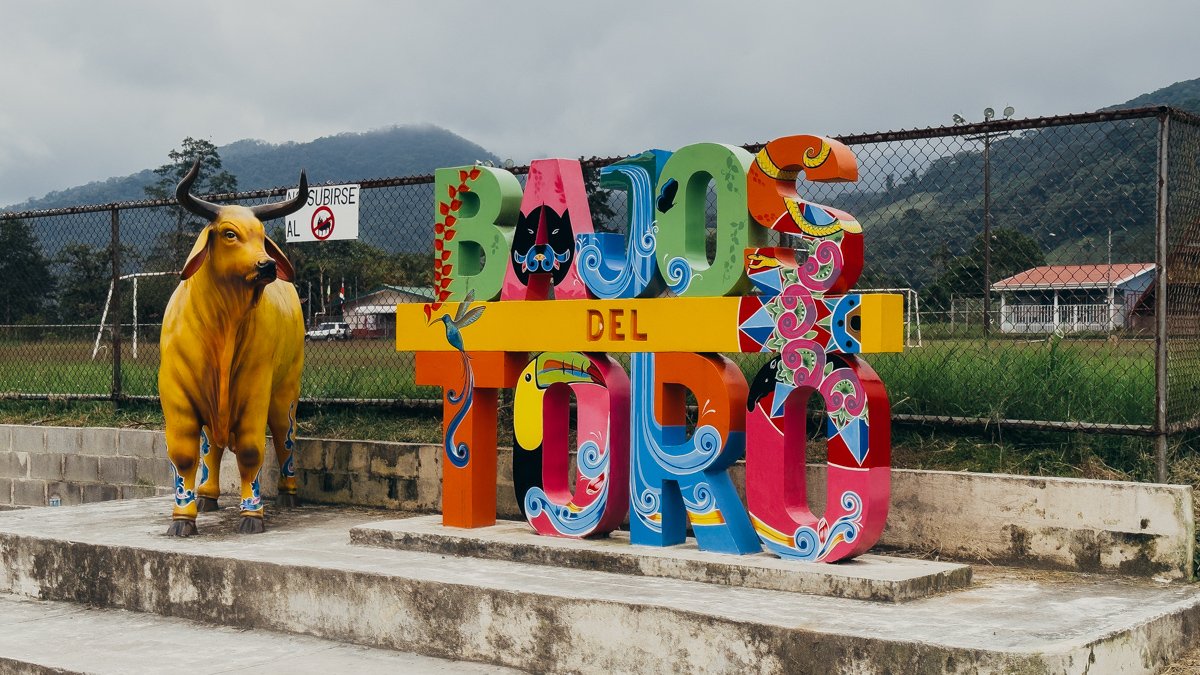
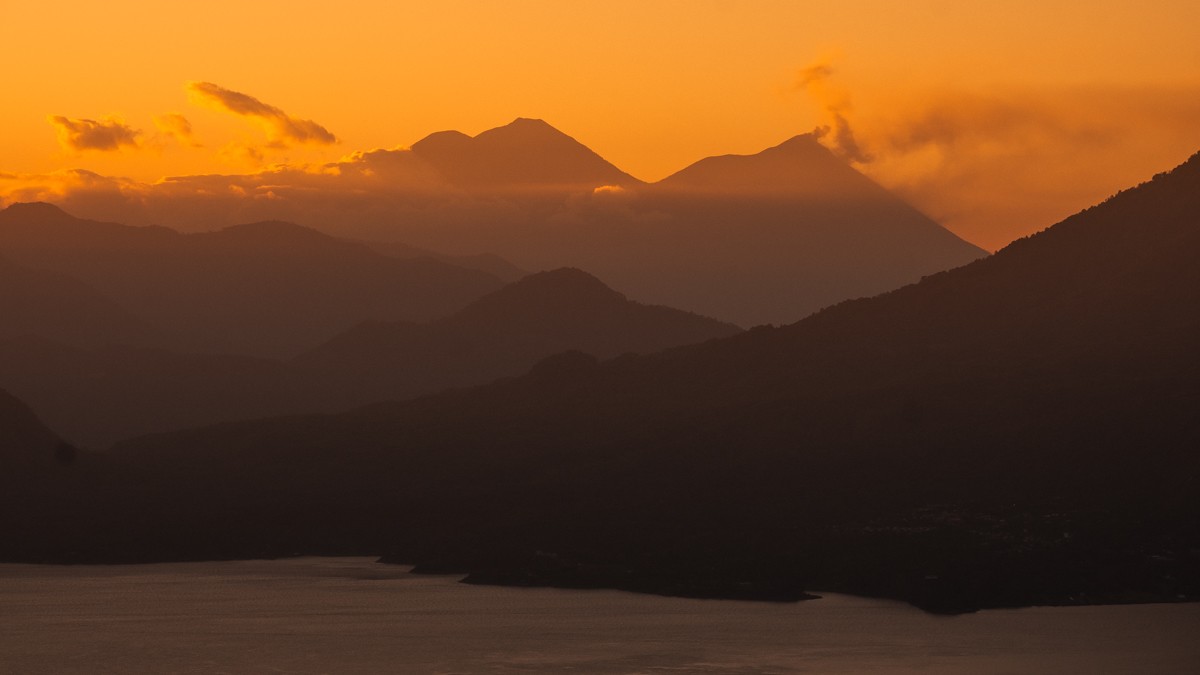
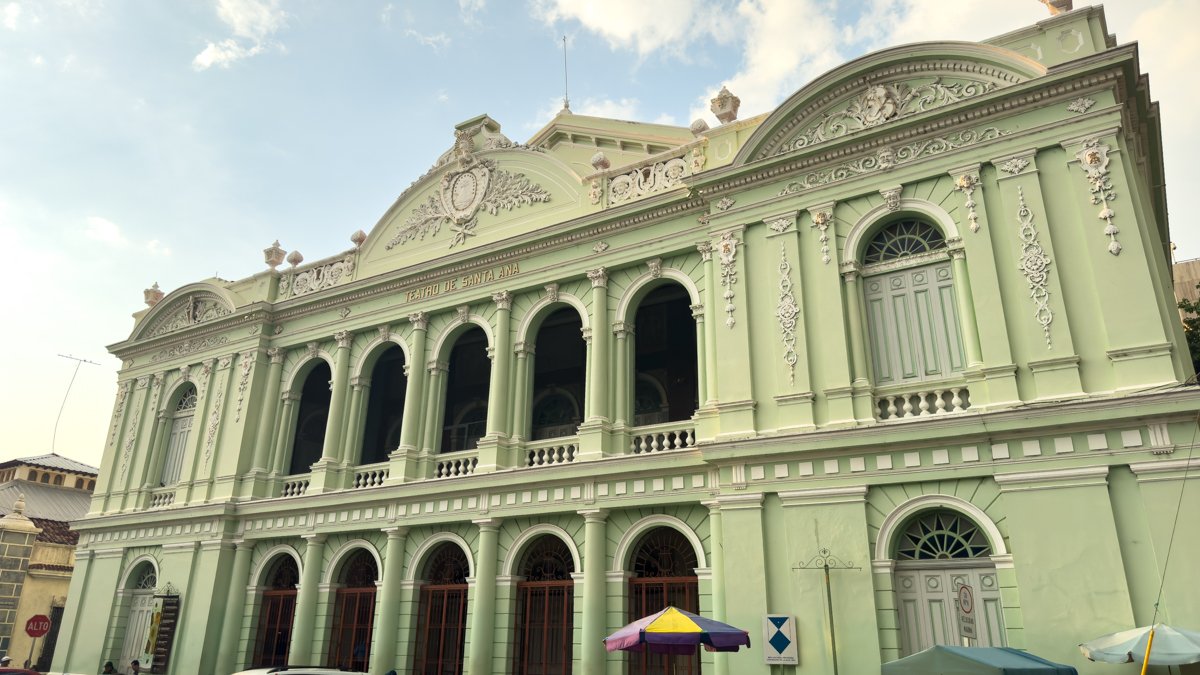
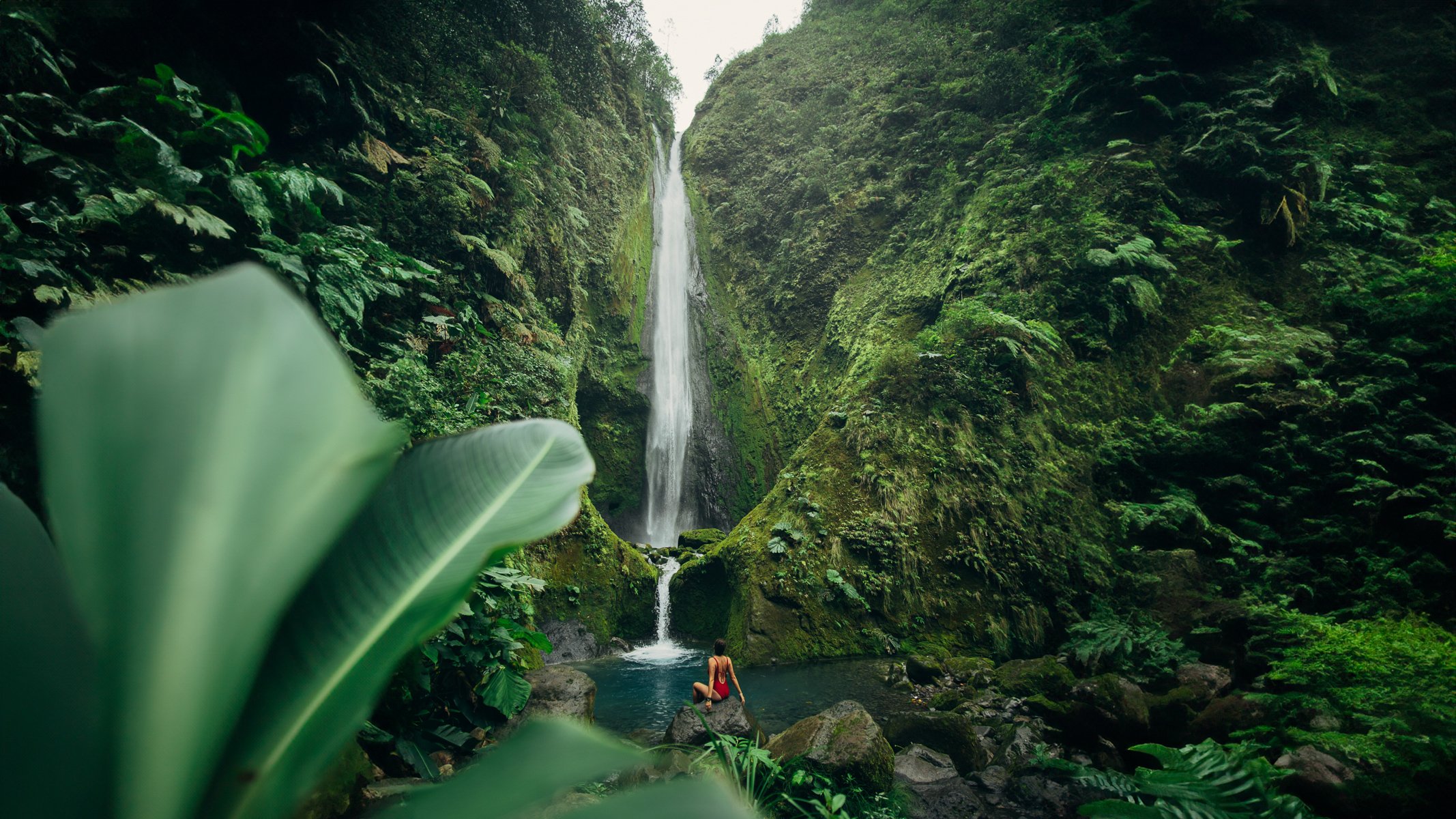
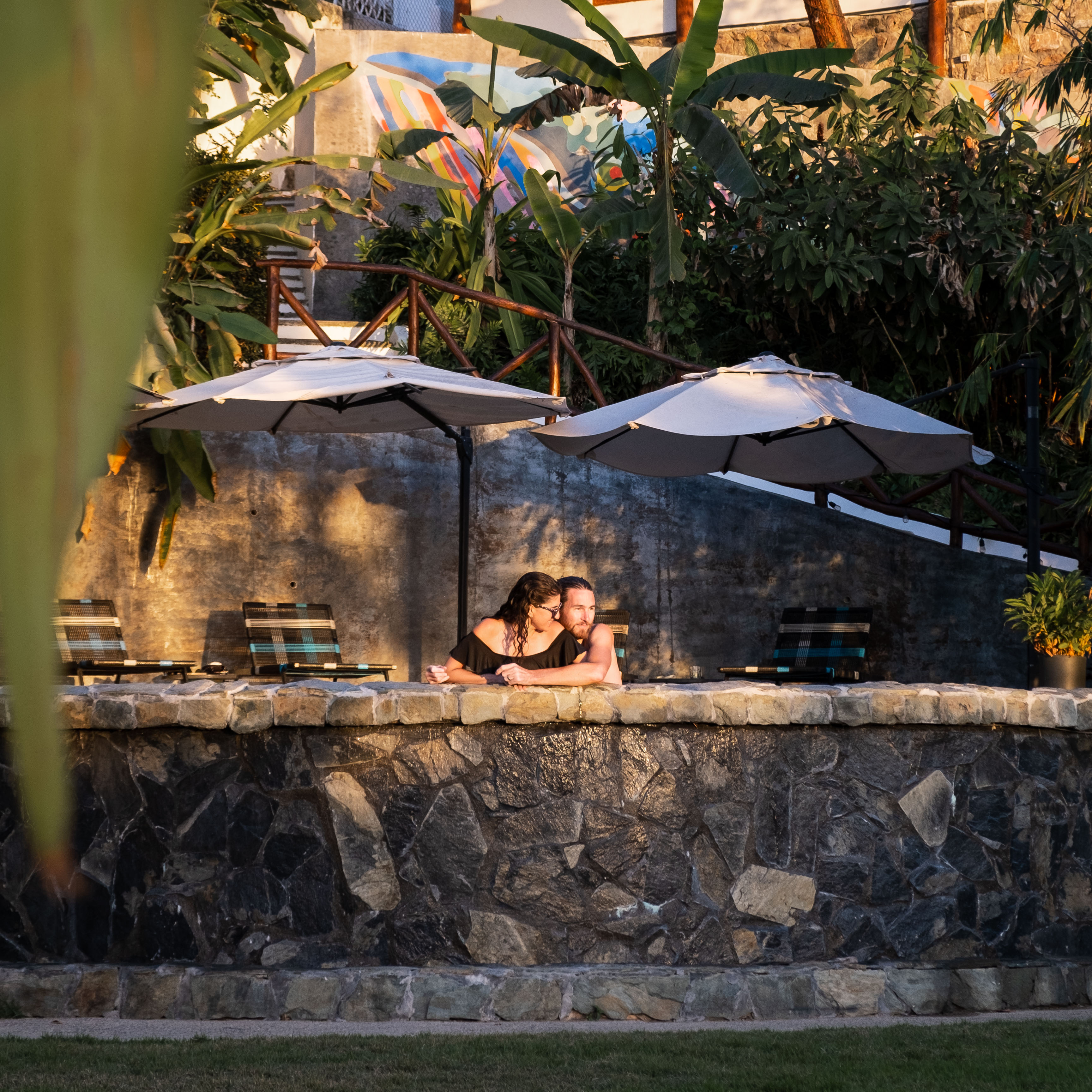


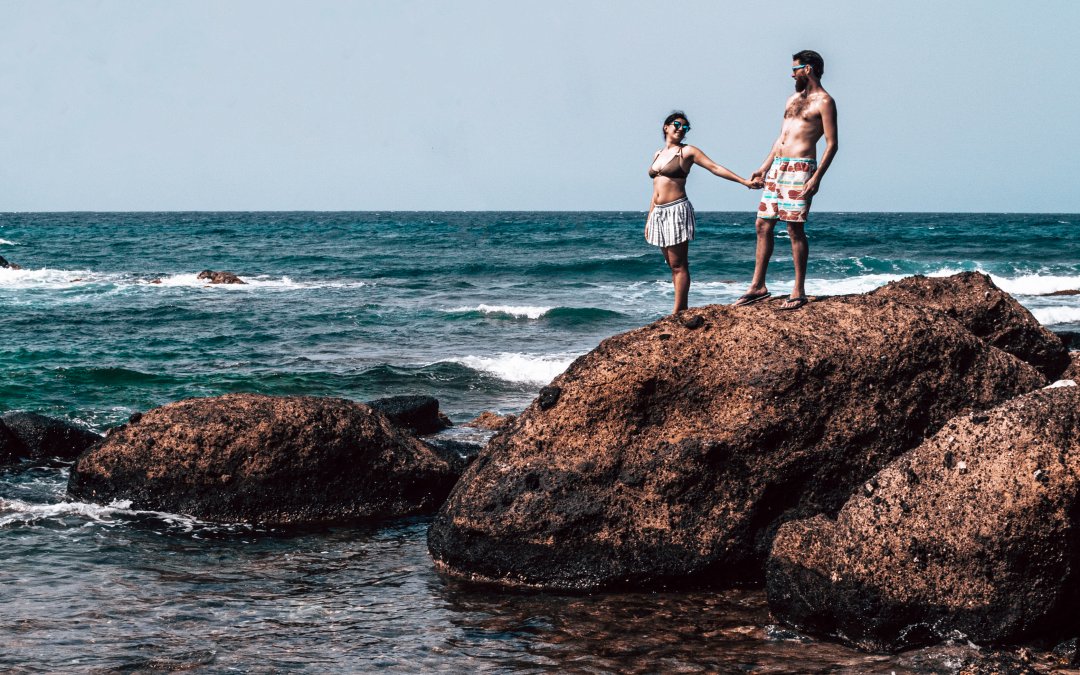
0 Comments